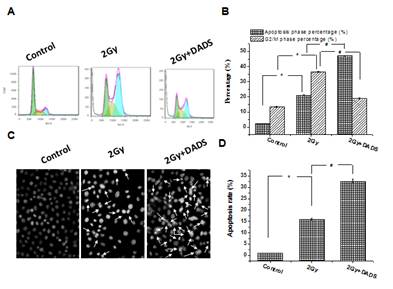Using the high-quality carbon ion beams offered by Heavy Ion Research Facility in Lanzhou (HIRFL), researchers of Radiation Medicine Group at Institute of Modern Physics, Chinese Academy of Sciences (IMP) have found a new molecular mechanism for carbon ion irradiation-induced apoptosis.
Cell apoptosis is a key mechanism through which ionizing radiation kills tumor cells. p73, belonging to the p53 family of transcription factors, is rarely mutated or lost in cancers, but has high expression. The role of p73 in tumor is still under debate. The p73 locus encodes 2 types of isoforms: full length pro-apoptotic isoforms (Tap73), and N-terminally truncated anti-apoptotic proteins (DNp73). However, the effect of p73 isoforms on high-LET carbon beams - induced cell death remains unknown.
In this study, the researchers found that radiation effects evoked by high-LET carbon beam were marked by inhibition of cell viability, cell cycle arrest and significant rise of apoptotic cells (Fig. 1). The molecular mechanism is that high-LET carbon beam regulated p73 alternative splicing, induced p73-mediated death receptor and mitochondrial apoptosis signaling pathway, and thereby promoted tumor cell apoptosis (Fig. 2). Additionally, Diallyl disulfide (DADS), an oil-soluble compound extracted from garlic documents not only as a potential radio sensitive agent but also as a potential radio protection agent. Combination DADS and the radiation exacerbated the activation of apoptosis pathways in tumor cells through up-regulated Tap73/ΔNp73 ratio, and its downstream proteins, such as FASLG, and APAF1. Interestingly, combination DADS and the radiation in normal cells inhibited apoptosis through down-regulated Tap73/ΔNp73 ratio, but promoted DNA damage repair. This finding is the first to reveal a new molecular mechanism of high LET radiation-induced apoptosis, and it is possible to enhance the effect of heavy ion radiotherapy and to clarify the mechanism of their safety to provide new ideas.
This work was supported by grants from the Key Program of National Natural Science Foundation of China (U1432248), and National Natural Science Foundation of China.
This work has been published in Scientific Reports, 2015, 5: 16020 and Cell Cycle, 2015, DOI:10.1080/15384101.2015.1104438
The articles can be linked as follows:
http://www.ncbi.nlm.nih.gov/pubmed/26505313
http://www.nature.com/articles/srep16020

Fig.1 High-LET carbon beams inhibited cell cycle arrest, but induced apoptosis in tumor cells. Additionally, cells pretreated with DADS obviously promoted radiation-induced apoptosis(Image by IMP)

Fig. 2 Effect of Tap73 and ΔNp73 on tumor cells exposed to high-LET carbon beams and cells pretreated with DADS obviously up-regulated Tap73/ΔNp73 ratio (Image by IMP)

